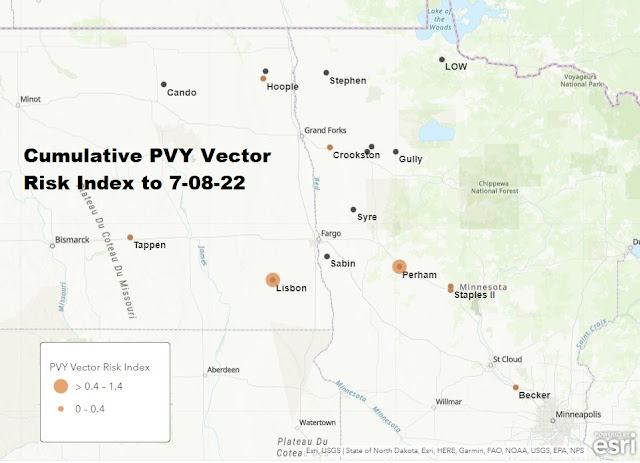Trap Catches to Aug 19, 2022.
What a difference a week makes. The increasing presence and distribution of Green Peach Aphid in the region has driven the PVY Vector Risk higher than last year's at this time.
Potato Virus Y is a non-persistent virus, aphid vectors acquire the virus when probing & feeding on an infected plant. The aphid then transmits the virus to the next uninfected plant upon which it feeds. Most of this transmission is by winged aphids, as they move through a field, testing plants to assess their value as a potential food host.
Green Peach Aphid (GPA) is, by far, the most efficient vector of Potato Virus Y. It can acquire the virus from an infected plant faster than other species of aphid and can transmit it more readily. Consequently, it's presence increases the risk of PVY inoculum being moved in a seed potato field much more than does the presence of any other aphid species. So, while the number of aphids being trapped this week that vector PVY are still below that of 2021, the importance of GPA as a PVY vector increases the Risk Index more than any other aphid that can vector PVY. The weighting of increasing numbers of that species can be seen in the sharp rise of the seasonal increase in the accumulating average PVY Vector Risk Index of this season (right graph below) as compared to our 2013-2020 average (left graph below)
(Click on image for larger version)
Green Peach Aphids have been collected from a number of widely distanced locations and were numerous at several locations. Overall, regional PVY vector captures increased again this week. Trap numbers were almost 70% higher than last week, indicating we have not yet reached the population peak. Other vector species are increasing in number and distribution as well. Cereal aphids continue to rise and remain numerous at most locations, with all species increasing except Bird Cherry Oat Aphids. Soybean Aphid capture numbers doubled this week and were recovered at all but 2 locations; Buckthorn Aphids were also numerous and recovered in most locations. Both Damson Hop and Cannabis Aphids were recovered this week. Numbers of both Thistle and Cotton/Melon Aphids increased this week and were found at most locations.
With aphid vector numbers still increasing, and keeping in mind most of our PVY results from late season transmission, appropriate management tactics should be considered. Monitoring aphid populations and keeping seed fields clean is increasingly important this time of year.
So... Keep scouting, and we'll keep counting...
Click on any image below for full-scale version.
Cumulative PVY Vector Risk Index to Aug. 19, 2022
Cumulative PVY Vector Risk Index to Aug 20, 2021 (please note different scale)
Aphid Species Capture and PVY Vector Risk Index for the week ending Aug 19, 2022
Cumulative Aphid Species Capture and PVY Vector Risk Index to Aug 19, 2022















































